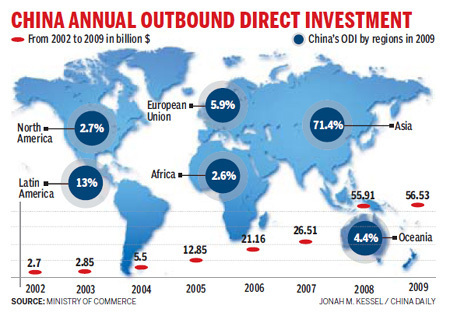"... {China's August} Production gained 13.9 percent from a year earlier ... Consumer prices jumped 3.5 percent, the most in 22 months, as food costs climbed. Retail sales increased 18.4 percent. {Despite} curbs on bank lending and government crackdowns to cool the property market and meet energy and pollution targets. ...
“Domestic demand is robust and the Chinese economy is heading for a smoother and softer landing than people had feared,” said Lu Ting, a Hong Kong-based economist at Bank of America-Merrill Lynch. ...
Inflation is 1.25 percentage points above the benchmark one-year deposit rate*, encouraging savers to shift money into assets such as real-estate and adding to public concern about rising prices. ... China is poised to replace Japan as the world’s second- biggest economy this year after reporting a larger GDP in the second quarter. {by some accounts it already has.}
... Producer price inflation slowed to an annual 4.3 percent pace from 4.8 percent. “This is a positive set of data which shows the economy has ended its deceleration,” said Stephen Green, Shanghai-based head of China research for Standard Chartered Plc.
In a separate statement, the central bank reported August new loans of 545.2 billion yuan ($80 billion) and a 19.2 percent increase in M2, the broadest measure of money supply. Both numbers were above economists’ estimates. The rebound in M2 growth was the first in nine months.
Trade data released yesterday signaled strength in Chinese demand, with imports jumping 35 percent from a year earlier in August, more than economists forecast. Last month also saw gains in property transactions and auto sales, led by SAIC Motor Corp. and FAW Car Co.
The economy expanded 10.3 percent in the second quarter from a year earlier after an 11.9 percent gain in the first three months of the year. Industrial output rose 13.4 percent in July. ...
Industrial-output growth may average 10 percent in the second half as the government chases energy-efficiency targets in a five-year plan, the Ministry of Industry and Information Technology said Sept. 7. The ministry also cited risks to export demand, efforts to cool the property market and a limit to growth due to comparisons with higher year-earlier bases.
In China’s north, Hebei, the nation’s largest steelmaking province, is demanding that producers such as Tangshan Iron & Steel Group and Shougang Corp. curb output to save energy, according to a local-government website. Crude steel output fell to a six-month low last month, the statistics bureau said today. {But China is importing steel also as many steel intensive projects exist like new high speed rail lines.}
From:
http://www.bloomberg.com/news/2010-...3-9-in-august-inflation-quickens-to-3-5-.html
-------------
*This is like Japan. The saving habit is so strong that the people put money in the banks even when the real rate of return is negative! Billy T expects the Chinese will increasingly buy and hoard silver. It is the official CCP policy that they should do so for about a year now. This helps the government convert dollars into real assets without any reduction in government funds.









